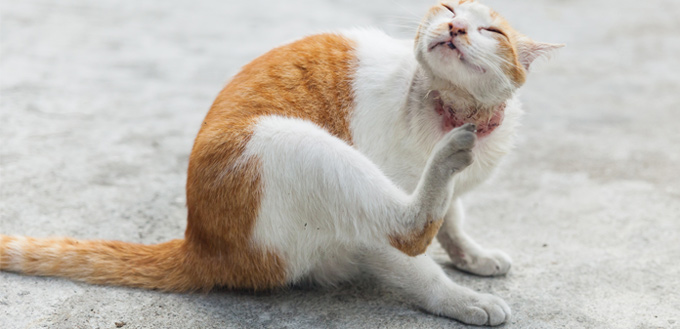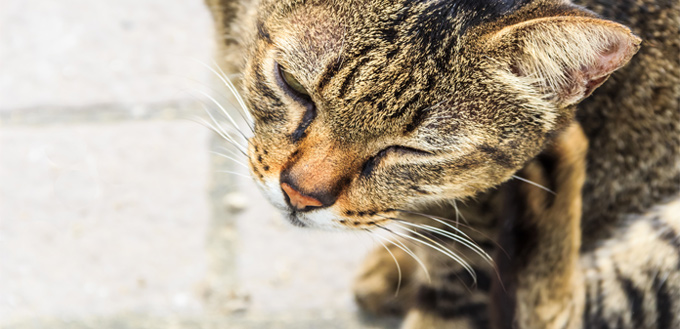Mange or scabies is a very itchy skin condition that is very common among dogs. However, this doesn’t automatically mean that your feline friend is already immune to such a condition. While mange is quite uncommon in cats, it does present with many of the characteristic symptoms of canine mange. There is intense itching or even frantic scratching. This can lead to patchy hair loss or even a certain area in your pet’s skin that looks like it has been eaten by moths. Mange in cats may not be as common as mange in dogs, but they do occur especially in households or neighborhoods where there is an interaction between these two pets. Learning more about this condition should help you provide more appropriate care for your feline pet.
What is Mange and What Causes It?
By definition, mange is used to describe a type of skin condition that is caused by certain species of mites, especially those that are parasitic by nature. In other words, mange is the reaction of the cat in response to the activities of mites on its body.

Mites are actually arthropods belonging to the same class as spiders, scorpions, and ticks as well as many other eight-legged invertebrate freaks. It should be noted that not all mites are parasitic; some actually live on plants, in the soil, and even in water. They serve a variety of roles in the ecosystem such as decomposers. The parasitic kinds of mites are known to cause allergies as well as other diseases because of the other microorganisms that they transmit to a new host.
Parasitic mites do not only affect dogs and cats. They can also affect livestock and wild animals like bears, coyotes, and cougars. Birds and reptiles are also known to be affected by these mites. But given the fact that there are different species of mites, only a handful can produce the now-classic manifestations of mange.
Currently there are two types of mange that affect the feline population.
- Sarcoptic mange or feline scabies
Sarcoptic mange is caused by the mite known as Notoedres cati, although quite uncommonly, it can also be caused by Sarcoptes scabiei. In the past Notoedres cati was believed to be a subtype of Sarcoptes scabiei. This leads to a type of mange that is called Notoedric mange or sarcoptic mange. Notoedres cati live in deep burrows in the cat’s outer layer of skin. In some cases, the burrows are so deep that they reach the stratum lucidum and granulosum. Because the mite burrows deep into the epidermis of the cat, it causes intense itching as well as patchy hair loss. This can lead to drying and scaling of the skin and become more susceptible to secondary infections.
- Demodectic mange
Demodectic mange in cats is caused by two types of mites, Demodex gatoi and Demodex cati, giving rise to demodectic gatoi and demodectic cati, respectively. Demodex gatoi is more of a surface dweller rather than a burrower. However, it can still cause extreme itching that can pave the way for secondary infections. These are short and stubby critters that can be easily transmitted anytime. On the other hand, Demodex cati are a lot similar to the Demodex canis of dogs. They are the opposite of Demodex gatoi – long and skinny. They are mostly found within hair follicles which can spread to the surrounding skin. This leads to either localized form or a more generalized type of demodectic mange.
How Do Cats Get Mange?
Mange is relatively uncommon among cats, this is certain. However, because of the interaction between cats and dogs and other animals both in the house and in the environment, it is possible for cats to get the mites that cause this kind of skin condition.
Cats that have close interaction with dogs that are currently infected with Sarcoptes scabiei can actually become temporary reservoirs for this type of mite. This can lead to transient pruritus or itching that is not really that intense or doesn’t last that long. However, there is a general observation that cats with a compromised immune system may develop lesions that produce persistent itching. Feline scabies is mostly found among feral or stray cats especially those that live in highly unsanitary environmental conditions. They are also found in cats that live in places close to the habitat of rabbits and foxes.
If feline scabies can be easily transmitted from other animals, demodectic mange in cats cannot, unless the cat’s immune system is compromised. Experts say that the development of demodectic mange in cats is more an indication of the failure of its immune system in protecting it against these mites rather than the actual pathology that these organisms cause. The current notion is that cats need to be infested by large numbers of demodectic mites for the disease to present itself.
Find out more about Cat Skin Problems
How Do I Know If My Cat Has Mange?
It is quite easy to find out if your cat has mange since the condition is mostly confined to the skin. As such, any change in the skin’s appearance, including that of the hair follicles, can lead you to suspect that your feline friend may have mange. This is especially true if the skin symptoms that you see are accompanied by frantic scratching by your cat.
Since sarcoptic mange or feline scabies is characterized by Notoedres cati actually burrowing itself deep into the outer layer of the cat’s skin, the manifestations can be exceptionally more severe compared to demodectic mange in cats. The burrows cause localized inflammation which can lead to redness, warmth, and swelling in the affected area. Mast cells and other tissue cells are damaged, releasing a variety of pro-inflammatory substances including histamine and heparin. It is histamine that causes the intense itching that no amount of scratching will ever relieve. The inflammatory changes occurring at and surrounding the burrow lead to keratinization of the deeper layers forming crusts and flakes like dandruff. The inflammatory changes also affect the hair follicles deep in the skin leading to loss of hair which can be best described as patchy.
Lesions can also develop because of breaks in the skin’s integrity which can be made worse by the intense scratching of the cat. The lesions can harden causing the hair or fur within the tissue to be compressed leading to hair loss. Sadly, no new hair will also be growing in this part of the skin because of the physiologic changes at the tissue level.
The main problem in sarcoptic mange is the risk of secondary skin infections. The skin is the home of several species of bacteria and fungi that normally do not produce infections because of the barrier afforded by the skin. Unfortunately, scratching leads to breaks in the integrity of the skin, leaving openings for bacteria and fungi to enter the inner layers of the skin. This is what causes secondary skin infections.

Demodectic mange, on the other hand, is usually milder in form than sarcoptic mange since Demodex gatoi and Demodex cati only affect the skin surface and the hair follicles, respectively. As such, one can say that these organisms are more superficial compared to Sarcoptes scabiei or Notoedres cati that need to burrow deep inside the epidermis.
While Demodex gatoi only inhabits the surface of the cat’s skin, it can still produce local irritation that can damage the skin tissues underneath it. This releases pro-inflammatory substances that cause intense itching, redness, and localized superficial swelling. It is like an ant biting the skin. It is on the surface of the skin but can still leave tell-tale signs of the bite. Demodex gatoi causes intense itching which leads to frantic scratching. Once the cat’s skin integrity is broken, lesions can develop and secondary skin infections can occur.
Demodex cati, since it primarily affects the hair follicles, can produce patchy hair loss as its main clinical manifestation especially the areas around the eyelids, the neck, the chin, and the face. Localized lesions can also form as the cat inadvertently moves the mite towards the base of the hair shaft causing localized inflammation and itching. If there are lesions in at least 5 different areas of the cat’s body, it is classified as generalized feline demodectic mange. Otherwise, if it is only confined to a specific area, then it’s localized.
How is Mange Diagnosed?
Sarcoptic mange, since it burrows deep in the skin, requires scraping the skin and examining the scraped skin tissues under the microscope. This helps provide a more definitive identification of the Notoedres cati or the uncommon Sarcoptes scabiei in establishing the presence of sarcoptic mange in cats or feline scabies.
On the other hand, since demodex cati and gatoi are found on the hair follicles and skin surface, visual identification is a must. Unfortunately, this may not be really easy since they are small. Skin scrapings may also need to be examined under the microscope. Microscopic examination of the cat’s hair can also help identify the presence of Demodex cati. A much safer alternative is to examine the stool of cats. Because felines are fastidious groomers there is a strong likelihood that they will ingest the mites that cause demodectic mange and these will be present in the stool.
How Can Mange Be Treated in My Cat?
The identification of the causative organism of mange in cats paves the way for a more successful resolution of the problem, although experts say the skin condition typically resolves on its own. The management of mange in cats is a combination of organism elimination and symptomatic management.
Your vet can give you medications that have acaricide properties. There are flea and tick medications that are also effective against sarcoptic and demodectic mange. These cat flea treatments can be an excellent way for killing and controlling mange mites. These are available in topical spot-on applications or as shampoos and dips. The important thing to remember is to stick to a brand that your vet has recommended as he knows exactly what active ingredient your cat should be receiving.
Another point to keep in mind is to never use flea treatment that is intended for dogs only. Many of these products are very efficient in killing pests in dogs but can be very toxic to cats, so beware.
Flea treatments with acaricidal properties only kill the invading mites. However, it doesn’t instantly relieve the symptoms of intense itching or even inflammation since these manifestations will still persist long after the mites are killed. As such antihistamines may be given to your pet in an effort to minimize the intensity of the itch.
If there is a secondary skin infection, the appropriate antimicrobial will have to be administered. If it’s a fungal infection, you can expect the antifungal treatment to be longer than antibacterial therapy since fungi are more resilient than bacteria.
How Can I Protect My Cat Against Mange?
Sarcoptic mange in cats is most often related to interspecies transmission of the causative agent. As such, the only way you can really protect your pet against sarcoptic mange is to keep them away from dogs and other animals that may harbor these pests. Keeping your pet inside your home should do the trick.

Demodectic mange is almost always associated with a compromised immune system functioning. Boosting your pet’s immune system through well-balanced nutrition and feline food that is rich in antioxidants and essential fatty acids is often a wise choice.
Related Post: Best Wet Cat Food
If your pet already has feline mange and you have other pets in your house, make sure to treat them also. Otherwise, you are only stopping one from getting infected. Once the treatment has waned, mites from the other pests can reinfest your just-treated cat.
Make sure to clean your pet’s belongings, too. This can include vacuuming its bedding, favorite toys, collars, and even dishes. If the item can be washed or immersed in hot water, then you can safely do so.
Mange in cats, albeit uncommon, is almost the same as mange in dogs. It is the intense itching that is the major culprit which can lead to secondary infections. Thankfully there are ways in which this skin condition can be easily treated and prevented.
Related Post: Best Cat Toys and Best Cat Collar
Sources:
- Notoedric Mange in Cats, Pet Health Network
- Martin Knaus, Therapeutic Efficacy Of Broadline® Against Notoedric Mange In Cats, SpringerLink
- Cat Mange and Scabies: Symptoms, Causes, and Treatments, WebMD







